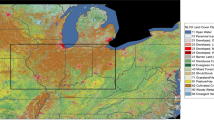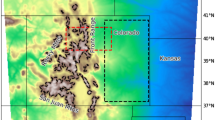Abstract
Our study found that local mesoscale circulations associated with highlandareas, and transient evapotranspiration discontinuities, are likely to influencethe timing and location of the initiation of deep convection across the Canadianprairie provinces when synoptic-scale forcing is weak (e.g., weak low level windsand no frontal boundaries). The cumulus congestus and cumulonimbus clouds thatformed over the highland areas were initiated by anabatic wind induced mesoscalecirculations. These deep convective clouds generally formed relatively early in theday (about 1030 Central Standard Time (CST)). In the relatively flat cropped grasslandregion, transient evapotranspiration gradients influenced the location of deep convectioninitiation, and the average soil moisture in the root zone had a direct impact on theirtiming. As root zone soil moisture declined from greater than 70% to less than 30%,convection initiation was delayed from about 0930 to 1630 CST. Cumulus congestusand cumulonimbus clouds that formed over the ephemeral evapotranspiration gradientswere initiated by land-land circulations. The study has improved the understanding ofthe influence of local surface forcing on the development of deep convective cloud onthe Canadian prairie provinces. The identification of areas where deep convection islikely to be initiated with weak synoptic forcing will also aid in the forecasting ofthunderstorms in this region.
Similar content being viewed by others
References
Angevine, W. M., Baltink, H. K., and Bosveld, F. C.: 2001, 'Observations of the Morning Transition of the Convective Boundary Layer', Boundary-Layer Meteorol. 101, 209–227.
Arora, V.: 2002, 'Modeling Vegetation as a Dynamic Component in Soil-Vegetation-Atmosphere Transfer Schemes and Hydrological Models', Rev. Geophys. 40, 1–26.
Basara, J. B and Crawford, K. C.: 2002, 'Linear Relationships between Root-Zone Soil Moisture and Atmospheric Processes in the Planetary Boundary Layer', J. Geophys. Res. 107(D15), 2–18.
Betts, A. K.: 2000, 'Idealized Model for Equilibrium Boundary Layer over Land', J. Hydrometeorol. 1, 507–523.
Bosilovich, M. G. and Schubert, S. D.: 2002, 'Water Vapor Tracers as Diagnostics of the Regional Hydrologic Cycle', J. Hydrometeorol. 3, 149–165.
Canada Committee on Ecological Land Classification: 1989, Eco-Climatic Regions of Canada, Ecological Land Classification, Series No. 23, Environment Canada, Ottawa, ON, 118 pp.
Emori, S.: 1998, 'The Interaction of Cumulus Convection with Soil Moisture Distribution: An Idealized Simulation', J. Geophys. Res. 103(D8), 8873–8884.
Hadfield, M. G., Cotton, W. R., and Pielke, R. A.: 1991, 'Large Eddie Simulation of Thermally Forced Circulations in the Convective Boundary Layer. Part I: A Small-Scale Circulation with Zero Wind Speed', Boundary-Layer Meteorol. 57, 79–114.
Lee, S-H. and Kimura, F.: 2001, 'Comparative Studies in the Local Circulations Induced by Land-Use and Topography', Boundary-Layer Meteorol. 101, 157–182.
Lemone, M. A., Grossman, R. L., McMillen, R. T., Liou, K.-N., Ou, S. C., McKeen, S., Angevine, W., Ikeda, K., and Chen, F.: 2002, 'CASES-97: Late Morning Warming and Moistening of the Convective Boundary Layer over the Walnut River Watershed', Boundary-Layer Meteorol. 104, 1–52.
Mohr, I. K., Baker, R. D., Tao, W-K., and Famiglietti, J. S.: 2003, 'The Sensitivity of West African Convective Line Water Budgets to Land Cover', J. Hydometeorol. 4, 62–76.
Pielke, R. A.: 2001, 'Influence of the Spatial Distribution of Vegetation and Soils on the Prediction of Cumulus Convective Rainfall', Rev. Geophys. 39, 151–177.
Pielke, R. A. and Zeng, X.: 1989, 'Influence on Severe Storm Development of Irrigated Land', Nat. Wea. Digest. 14, 16–17.
Pielke, Sr., R. A., Avissar, R., Raupach, M., Dolman, A. J., Zeng, X., and Denning, S.: 1998, 'Interactions Between the Atmosphere and Terrestrial Ecosystems: Influence on Weather and Climate', Global Change Biol. 4, 461–475.
Pietroniro, A., Soulis, E. D., Snelgrove, K. R., and Kouwen, N.: 2001, 'A Framework for Coupling Atmospheric and Hydrological Models', in A. J. Dolman, J. W. Pomeroy, T. Oki, and A. Hall (eds.), Soil-Vegetation Atmosphere Transfer Schemes and Large-Scale Hydrological Models, Proceedings of the Maastricht Symposium S5, July 2001, IAHS Publ. No. 270, pp. 27–34.
Rabin, R. M., Stadler, S., Wetzel, P. J., Stensrud, D. J., and Gregory, M.: 1990, 'Observed Effects of Landscape Variability on Convective Clouds', Bull. Amer. Meteorol. Soc. 71, 272–280.
Raddatz, R. L.: 1993, 'Prairie Agroclimate Boundary-Layer Model: A Simulation of the Atmosphere/Crop-Soil Interface', Atmos-Ocean 31, 399–419.
Raddatz, R. L.: 1998, 'Anthropogenic Vegetation Transformation and the Potential for Deep Convection on the Canadian Prairies', Can. J. Soil Sci. 78, 656–666.
Raddatz, R. L.: 2000, 'Summer Rainfall Recycling for an Agricultural Region of the Canadian Prairies', Can. J. Soil Sci. 80, 367–373.
Raddatz, R. L.: 2003, 'Aridity and the Potential Physiological Response of C3 Crops to Doubled Atmospheric CO2: A Simple Demonstration of the Sensitivity on the Canadian Prairies', Boundary-Layer Meteorol. 107, 483–496.
Raddatz, R. L. and Cummine, J. D.: 2003, 'Inter-Annual Variability of Moisture Flux from the Prairie Agro-Ecosystem: Impact of Crop Phenology on the Seasonal Pattern of Tornado Days', Boundary-Layer Meteorol. 106, 283–295.
Raddatz, R. L. and Khandekar, M. L.: 1977, 'Numerical Simulation of Cold Easterly Circulations over the Canadian Western Plains Using a Mesoscale Boundary-Layer Model', Boundary-Layer Meteorol. 11, 307–327.
Raddatz, R. L., Ash, G. H. B., Shaykewich, C. F., Roberge, K. A., and Graham, J. L.: 1996, 'First and Second Generation Agrometeorological Models for the Prairies and Simulated Water-Demand for Potatoes', Can. J. Soil Sci. 76, 297–305.
Segal, M., Arritt, W., and Clark, C.: 1995, 'Scaling Evaluation of the Effect of Surface Characteristics on the Potential for Deep Convection over Uniform Terrain', Mon. Wea. Rev. 123, 383–400.
Segal, M., Avissar, R., McCumber, M. C., and Pielke, R. A.: 1988, 'Evaluation of Vegetation Effects on the Generation and Modification of Mesoscale Circulation', J. Atmos. Sci. 45, 2268–2292.
Tian, W-S. and Parker, D. J.: 2002, 'Two-Dimensional Simulation of Orographic Effects on Boundary-Layer Convection', Quart. J. Roy. Meteorol. Soc. 128, 1929–1952.
Zhu, P. and Albrecht, B.: 2002, 'A Theoretical and Observational Analysis on the Formation of Fair-Weather Cumuli', J. Atmos. Sci. 59, 1983–2005.
Author information
Authors and Affiliations
Rights and permissions
About this article
Cite this article
Hanesiak, J.M., Raddatz, R.L. & Lobban, S. Local Initiation of Deep Convection on the Canadian Prairie Provinces. Boundary-Layer Meteorology 110, 455–470 (2004). https://doi.org/10.1023/B:BOUN.0000007242.89023.e5
Issue Date:
DOI: https://doi.org/10.1023/B:BOUN.0000007242.89023.e5




